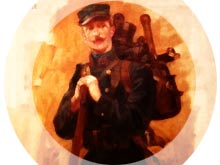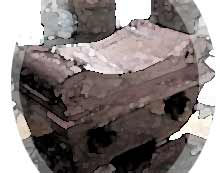For thousands of years all of Northern France has
endured an eventful position at the crossroads of European affairs. The city of
Paris – unchallenged heart of the region – has always been a factor
in the resulting conflicts, and yet it has miraculously survived intact.
Because the city is both strategic and relatively undamaged by the centuries of
war which have swept past, it has a wonderful sense of historical importance.
At Gare de l'est, it is easy to pause and think of the rows of young soldiers
sleeping along the walls of the train station, preparing for their voyage to
the trenches of World War One. Stand there and say to yourself; "they were
right here, with their
| Napoleonic Base Relief |
 |
clattering mess kits and creaking leather gear." That
is somehow more poignant than the eternal flame which commemorates the dead of
that great war, because before they died, many of those young men passed
through that very train station (Metro: Gare de l'est). The eternal
flame burns on at the Arc de Triumph, one of the great landmarks of Paris. This
particular triumphal arch was ordered into existence by Napoleon I, although it
was not completed until long after his passage from power. The arch features
base reliefs of Napoleonic scenes and is inscribed with the names of that era's
many battles, several of which are probably not even recognizable to many
Napoleonic scholars.
Anyone who has seen paintings of the French Imperial Guard
of the Napoleonic Wars marching under an arch will recognize the Carousel Arc
just west of the Louvre pyramid (Metro: Palais Royal Musée du
Louvre). That arch, with statues of the Famous bronze horses from
Constantinople atop, is the very arch that those guardsmen used to march
through. Nearby is the place where King Louis' Swiss Guards kept the Paris mob
at bay, and across the Seine is the Conciergerie, last home of countless
victims of the 1793 Terror. And while you are in the area, walk up Rue Rivoli
and look up. Set into the stone walls high above traffic are statues of
Napoleonic generals, including the intrepid General of Engineers Jean-Baptiste
Éblé who helped the FrenchArmy escape from Russia.
Cities like this are important because they remind us that
history is not some static thing which exists only in books. These things
really happened. The famous people we read about actually breathed, cursed, ate
dinner and maybe even brushed their fingers along the same walls as us. Some of
them ended up buried in the Cimetière du père Lachaise (Metro:
Pere Lachaise). Not only can you find the graves of famous poets and
scientists there, but also Napoleonic Marshals Davout, Macdonald, St. Cyr,
Massena, Murat, Ney and Suchet, among others. The Kellermann family plot is
also there, as well as that of the able General Morand. Don't forget to locate
the tomb of Sergeant Hoff, a Franco-Prussian War soldier who rated a larger
than life bronze statue of both himself and his daughter, the later of whom is
wonderfully posed at the base of her father's pedestal as if writing on it with
a pen! 
| Tomb of Joachim Murat |
 |
The French Army Museum at Les Invalides (Metro:
Invalides) is certainly one of the premiere military museums of Europe.
Their collection ranges from ancient weapons and gear to an unparalleled
gallery of equipment, paintings and personal effects from the Napoleonic Wars.
Among the many ultra-rare Napoleonic items on display are some of Napoleon's
own uniforms and hats, as well as his field tent and personal trophies.
Uniforms from period armies are too numerous to count, and include those of
marshals, senior officers, infantry, cavalry and guards. Residing in a sombre
position at the end of the wing is the armored cuirass of Carabinier trooper
Antoine Faveau, who suffered a dramatically fatal direct hit from a British
cannon ball at the battle of Waterloo in 1815. And while the museum contains
priceless artifacts, it was out in the courtyard where, in 1814, the elderly
Marshal Séurier burned Frederick the Great's decorations rather than
allow them to be recaptured by the approaching Prussian army.
| Holed Cuirass |
 |
The World War One wing of the museum has a complete
selection of Great War uniforms, weapons and other unusual items such as a
large piece of shrapnel from the German "Paris Gun", its rifling grooves
clearly visible. Within a nearby display case lies a 1916 French infantry
uniform, still covered with the mud of Verdun. Also at the museum are three
dimensional situation maps created in the last century for contingency
planning. These wonderful creations are huge, room-sized dioramas of major
French cities and their surrounding terrain, and they are displayed in a new
climate controlled wing.
Do not miss the Musée National de la Marine, an
exceptional naval museum containing a wealth of paintings, fittings and large
scale ship models. Their displays include a section of mast from a 74 gun ship
of the line, the ram bow of an ancient trireme, and a "torpedo room" with
original examples. The museum is located on the Trocadero, from which you can
get that world famous view of the Eiffel Tower.
| Modern French Cavalry |
 |
Parading cavalry squadrons and their regimental bands
are not everyday occurrences in Paris, but they are spectacular when seen. It
certainly brings back the feel for what it was like to see columns of dragoons
and cuirassiers moving through town in the days before the wide boulevards were
blasted out of the urban sprawl during the middle of the 1800s. The clattering
noise of even a hundred cavalry can be heard at a distance, and the regimental
bands can be heard for blocks. The cavalry column shown here was part of a
government demonstration carried out in the spring of 1987, when there was a
simultaneous threat of student unrest and terrorist attacks. They apparently
thought that large columns of scouting cavalry would be an inspiring, yet
powerful reminder to potential trouble makers. They also thrilled the tourists,
and therefore served a dual purpose. All through that summer, mobile cavalry
columns ranging from 8 to 80 troopers could be seen ranging throughout the
city, always friendly but always watchful.

One final note. Any student of history will recognize many
of the names for the streets and avenues of Paris, not to mention the metro and
rail stations. Gare d'Austerlitz, Rue la Fayette, Stalingrad, Boulevard
Berthier and there is of course, a rather modest Rue Bonaparte. Avenue de la
Grand Armée runs between Place de la Porte Maillot and Arc de Triomphe,
where it meets Avenue Foch, Avenue Kléber and fittingly; Avenue
Friedland!
| Avenue de la Grande Armee |
 |
Weeks can be spent discovering new sights around Paris, even
those relating to military history. But any visitor short on time would be best
served to head for the Army Museum. The Ecole Militaire is nearby and also well
worth a visit. Place Bastille, while historic, holds no trace of the original
Bastille, and is little more than a very large, smoggy traffic circle. Keep an
eye out for the many small plaques mounted along the streets and avenues around
town. They commemorate the people who died fighting the Germans immediately
before the Allies entered Paris in August of 1944. Many have fresh flowers on
them. |


